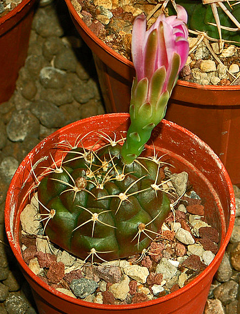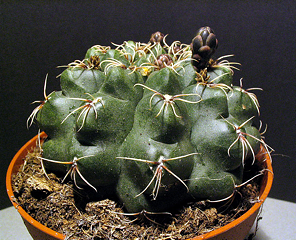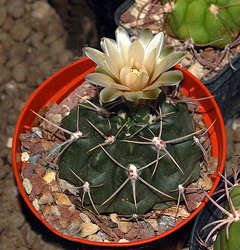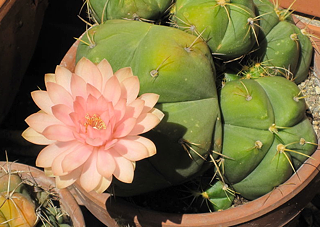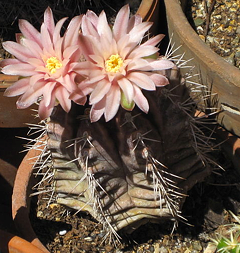Submitted by: Jim Tanner
Gymnocalycium are among the most popular of cacti, from the novice through the advanced grower. They are easy to grow; flower readily; come in a large number of distinguishable species; look great in flower, in bud, and even when dormant. A well grown plant will often flower several times during the year.
Gymnocalycium is an old genus, first named in 1845. The genus is named for the naked (spineless) calyx (the outermost covering of the bud and lower flower). Most Gymnocalycium are also readily identified by their ‘chins’ beneath the areoles.
The heart of the genus Gymnocalycium is Argentina, although the genus stretches into Southeastern Bolivia, Western Paraguay, Uruguay, and into the Southernmost part of Brazil. For the most part Gymnocalycium are grassland plants, growing and shaded in the grass of the Pampa and Chaco (dry forest) that covers much of Argentina. As a result, most like some protection from full afternoon sun, but need bright light during the day.
Gymnocalycium cultivation is easy. They need a dry rest during the winter; they can take Southern California climate without winter heat, as long as they are dry. They should be fed regularly with a weak general purpose fertilizer when growing. They are tolerant of any well drained soil, but constant wet will cause the roots to rot. Fortunately, they are easy to re-root, with roots generally re-growing in a just few months.
Gymnocalycium are easy to grow from seed, started in a well drained, damp potting mix in a plastic bag covered pot. Germination is fairly rapid, but growth during the first year is slow compared to most Mammillaria and many other genera. Vegetative propagation is also easy. Offsets from clumps can be removed, left to dry for a few days and potted. They generally root within a few weeks.
All the species and all the varieties and forms of Gymnocalycium are worth growing.
Tom Glavich
LATIN LOOKUP – Loquerisne Latine (Do you speak Latin)?
The meanings of latin plant names on this page – from http://davesgarden.com/guides/botanary/
- anisitsii [an-is-ITS-ee-eye]
Named for Prof. J. Daniel Anisits, 19th century Hungarian pharmacist and plant collector. - fischeri [FISH-er-ee]
Named for Friedrich Ernst Ludwig Fischer, 19th century German-born Russian botanist and St Petersburg botanical garden. - Gymnocalycium [jim-no-kal-LISS-ee-um]
From the Greek gymnos (naked) and kalyx (covering; calyx); the flower buds are naked. - horstii [HORST-ee-eye]
Named for Leopoldo Horst, 21st century Brazilian plant collector. - mihanovichii [me-han-oh-VIK-ee-eye, my-han-oh-VIK-ee-eye]
Named for Nicolas Mihanovich, 20th century Yugoslavian shipping magnate and patron of botany. - nova [NO-vuh]
New.
